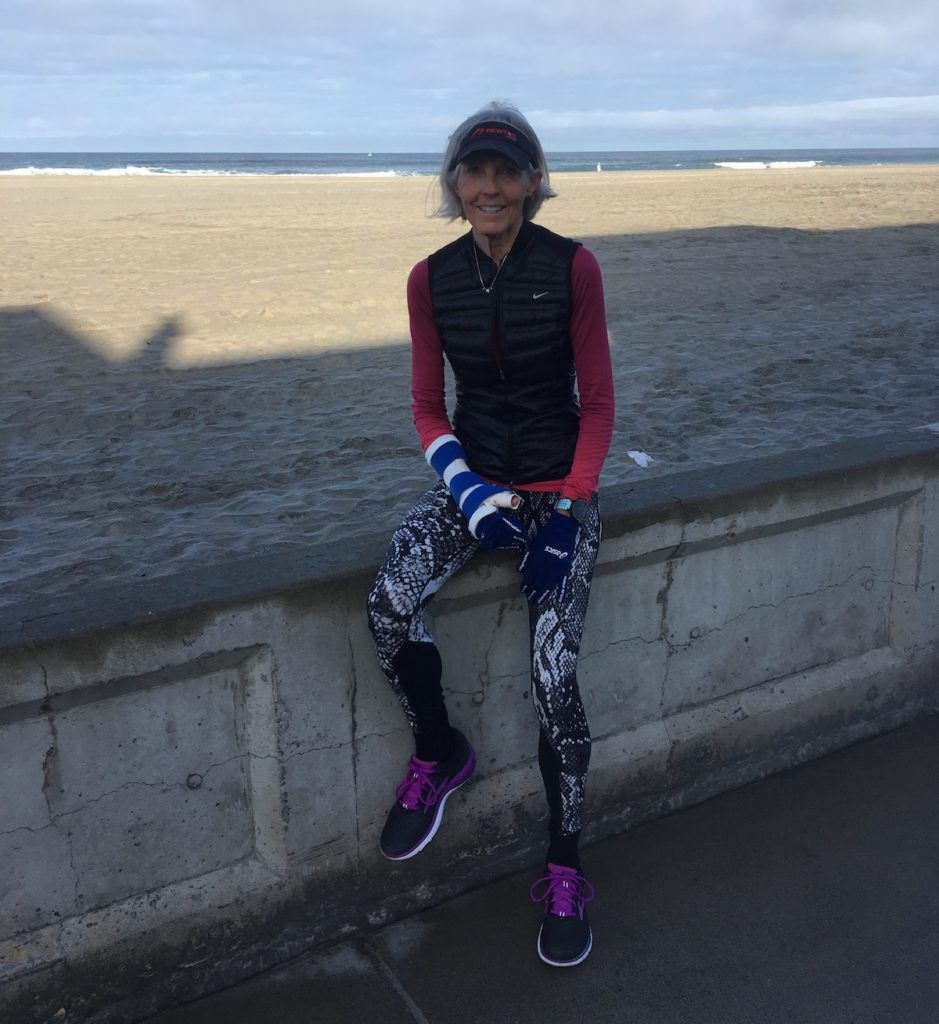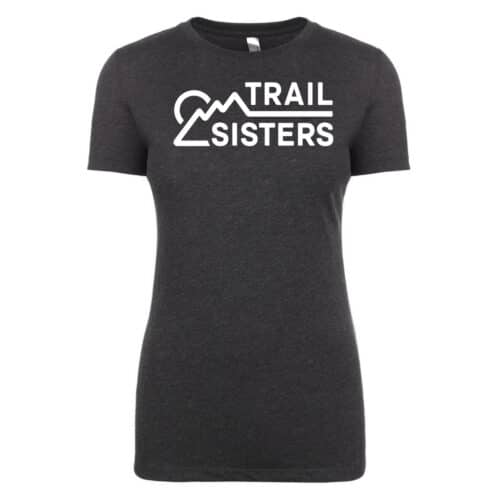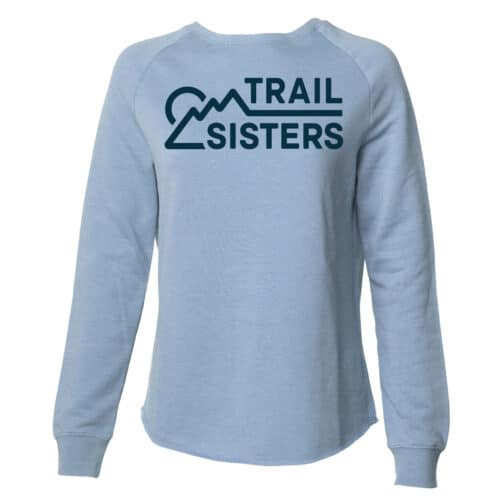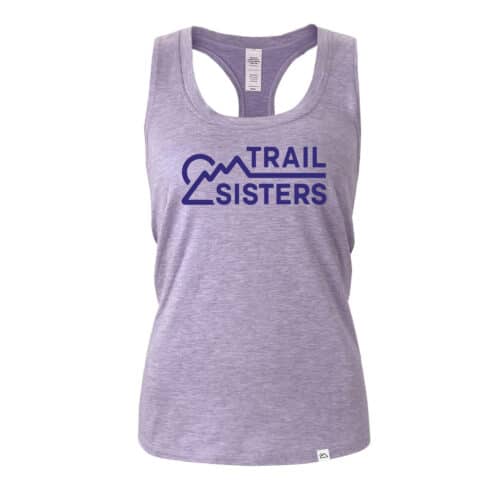Main Menu
The Porpoise and the Greyhound

Patricia has been long-time runner, starting while studying for the California bar exam. She is retired attorney, philanthropist, mother, grandmother, and wife. She loves being out-of-doors whether running, hiking, swimming, biking. Patricia has a blog for her musings and has written two books, “Smart Jocks, Long Talks and Pink Socks,” about her father, and “First Friends: Love, Loss and Life in Humboldt County,” about discovering running and friends during a tough time in her life.
Share This Article!


By: Patricia Burgess
“You have to embrace the porpoise to unleash your healthy inner greyhound.” I was puzzled by my friend’s note, after I’d informed him that my physical therapist said, “No running.” I’d torn my left hamstring; the injured area throbbed with sharp, shooting pain. Recovery would be slow. Running would exacerbate the problem. What does a dedicated, passionate runner do when she cannot run, felled by injuries? I was distraught, sad, frustrated. But then I remembered the times I’d been described in terms of animals.
“Anthropomorphism” is defined in the Merriam-Webster Dictionary as an interpretation of what is not human or personal in terms of human or personal characteristics. My friend’s comment slowly began to make sense. My situation was sort of reverse-anthropomorphism. I considered my history of naming, wanting to bolster my spirits, to find a way to address the intentional putting aside of running. Perhaps one of those animals that had playfully been assigned to me over the years would provide some guidance.
Porpoises are one of the fastest cetaceans (marine animals such as whales, dolphins and porpoises), with the ability to swim at speeds of up to 34 mph. They generally live in shallow coastal waters. Smaller than dolphins, they can be more aggressive and do not adapt to living in captivity. Female porpoises often give birth each year, with an eleven-month gestation period. Can you imagine, being pregnant almost all year every year?
Greyhounds are a gentle and intelligent dog breed whose combination of long, powerful legs, deep chest, flexible spine and slim build allows them to reach average race speeds in excess of 40 mph. They have short careers as racers; fortunately, due in large part to the efforts of rescue shelters, they are becoming more common as family pets. Maybe that will be my fate?

Roadrunners are long-legged, strong-footed ground cuckoos, living in the southwestern part of the United States. They can reach speeds as fast as 20 mph. They are also mascots for various sports teams, imagery to imbue athletes with visions of speed and winning. One of my favorite pieces of jewelry is a copper roadrunner pin, a physical reminder of this quick creature.
Rabbits are small mammals, with large, powerful hind legs. Jackrabbits hop quickly and at long distances, perhaps akin to track and field athletes who specialize in the long jump or triple jump. “Rabbit” also refers to someone who paces middle-to-long distance runners to ensure a fast speed, usually dropping out of the race at some designated point (except when an occasional rabbit decides to run for the win!).
During my junior high and high school years, I felt a misfit, chubby, nerdy, without physical grace. I discovered the YMCA as a place of consolation, of acceptance. I spent hundreds of hours with some of the other brainy girls as part of a synchronized swimming group (we called it water ballet back then; arguably more dance and art than athletics, it was not then an official summer Olympics Games’ event). We performed balletic moves to jazzy music; choreographed underwater dances; sewed sparkly sequins on our lacy costumes; participated in competitions. I was a mermaid, a sea horse, even a water baby as the silky water embraced me. I swam with grace and precision while my hair and skin were permanently infused with the faint perfume of chlorine. I could have floated forever. Pisces, my astrological sign, seemed appropriate.
Friends nicknamed me the roadrunner when we backpacked in the Trinity Alps of Northern California. Those granite peaks are glorious, isolated, accessed by little used, poorly maintained trails. The 55 alpine lakes are tucked beneath granite walls of the Red Trinities, the White Trinities, and the Green Trinities. We often hiked to Adams Lake, a tiny, crystal clear, cold lake off a rugged dirt road out of Weaverville, California, an old gold-mining town. I typically led the group, not because I was the natural trail-leader (that was Tom, who hiked to the lake as a child with his uncle) or map interpreter (the U.S. Geological Maps were critical for the hidden passages), but simply because I liked to move—quickly. I couldn’t abide going slowly, that is, until the day a baby bear stumbled across the steep shadowed trail just in front of me. Backwoods knowledge assured me that her mother would be close at hand. I decided that being in the middle of the group of hikers was smart. I curtailed my enthusiasm in the name of safety. Still, once we made camp, while the men fished, I scampered up and down the peaks, maybe a gazelle or sure-footed deer, free—but always on the watch out for danger.
A few years later, I started my life-long love affair with distance running. The activity began as the twin-antidote, along with swimming, to studying for the California bar examination. It morphed into so much more, as my form improved, my pace quickened, my running economy developed. I met other runners, who soon became my best friends, confidants, and substitute family. We logged ten, twelve, fourteen miles at a time. I became a trainer, sometimes even the rabbit, for a few of them who were training for the Avenue of the Giants marathon, a 26.2-mile course that weaves in and out of the towering redwoods and fern forests of the southern part of the county. While we each ran for different reasons, running was at the essence of our friendships, the tool to allow us to develop other passions and reasons to be together.

I suppose during these years I might have been considered a greyhound, as my silhouette changed from bulky pubescent teenager to slender, long-limbed young woman in the shadows of the sun as I ran the hills and trails above town. I felt freedom unlike any other in my life at that time. Running was my savior and my daily elixir. Those feelings lingered, even through the many years of being a mother, wife, and crazily busy attorney, when running took a backseat to daily life.
My friend is wise, a man I’ve known since kindergarten. He’s suffered injuries at various times, curtailing his skiing, racecar driving, and hunting. We’ve gone our separate ways only to reconnect occasionally by telephone or email or, in more sad times, at one of our respective parent’s funeral services. His admonishment to me was really a favor: find my other strengths. Running isn’t necessarily gone forever, just on hiatus.
So I found my way back to swimming, not synchronized swimming, but lap swimming. I took a few lessons to relearn breathing, to sway slightly, to glide more easily with less disruption through the water. I still need to learn the elusive kick-turn, but it will come. Then one day, swimming became poetry, different than running, but unique in and of itself.
When I swim, I imagine porpoises moving gracefully in the Pacific Ocean, impervious to outside worries (except cargo ships, ocean liners, and big globs of plastic waste). Once I slip into the pool, the laps glide by one after another. Bubbles trace the movement of my lingering fingers deep beneath my arm strokes, like duckling in a row behind their confident mother. I prefer the middle laps of the swim: my body sways slightly side to side and every third stroke my head turns, to the right, gathering breath, letting it out, then another three strokes and the same movement, this time to the left. The slight rumbling of my outlet air, the echoes of water slapping the pool’s edges, the occasional splash from a fellow swimmer are the only sounds to break this reverie. The rhythmic motion lulls me into believing we may once have been a more integral part of the ocean, the lakes and the rivers, the water our long-ago home. As I close in on the mile, I am forced to concentrate, my arms heavy, the kick of my legs less vigorous, and my breathing more labored. Yet I finish, refreshed, tired, and ready to start the work of the day. Running will still be there waiting for me, once my legs strengthen. Until then, the water is my world.
About the Author

Patricia has been long-time runner, starting while studying for the California bar exam. She is retired attorney, philanthropist, mother, grandmother, and wife. She loves being out-of-doors whether running, hiking, swimming, biking. Patricia has a blog for her musings and has written two books, “Smart Jocks, Long Talks and Pink Socks,” about her father, and “First Friends: Love, Loss and Life in Humboldt County,” about discovering running and friends during a tough time in her life.
Share This Article!




















One Response
Hello my name is Matthew D’Agati.
Solar technology happens to be probably one of the most promising and sought-after types of clean, renewable energy in the last few years. This really is because of its numerous benefits, including cost savings, energy savings, together with positive impact it offers regarding the environment. In this article, we shall discuss the advantages of choosing solar technology in homes and businesses, the technology behind it, and exactly how it may be implemented to optimize its benefits.
One of many benefits of using solar technology in homes is the cost benefits it gives. Solar energy panels are designed for generating electricity for your home, reducing or eliminating the necessity for traditional types of energy. This could lead to significant savings in your monthly energy bill, particularly in areas with a high energy costs. In addition, the price of solar energy panels and associated equipment has decreased significantly over time, which makes it less expensive for homeowners to buy this technology.
Another advantage of using solar energy in homes may be the increased value it can provide to the property. Homes that have solar energy panels installed are generally valued greater than homes which do not, while they offer an energy-efficient and environmentally friendly replacement for traditional energy sources. This increased value could be an important benefit for homeowners that are looking to sell their property as time goes by.
For businesses, the many benefits of using solar energy are wide ranging. Among the primary benefits is financial savings, as businesses can significantly reduce their energy costs by adopting solar technology. In addition, there are many different government incentives and tax credits offered to companies that adopt solar energy, which makes it a lot more affordable and cost-effective. Furthermore, companies that adopt solar power will benefit from increased profitability and competitiveness, since they are viewed as environmentally conscious and energy-efficient.
The technology behind solar power is simple and easy, yet highly effective. Solar panel systems are made up of photovoltaic (PV) cells, which convert sunlight into electricity. This electricity are able to be kept in batteries or fed directly into the electrical grid, with respect to the specific system design. To be able to maximize the advantages of solar power, you should design a custom system this is certainly tailored to your particular energy needs and requirements. This may make certain you have just the right components set up, like the appropriate wide range of solar panel systems together with right style of batteries, to optimize your time efficiency and cost savings.
One of many important aspects in designing a custom solar power system is understanding the different sorts of solar power panels and their performance characteristics. There are 2 main forms of solar power panels – monocrystalline and polycrystalline – each featuring its own pros and cons. Monocrystalline solar energy panels are produced from a single, high-quality crystal, which makes them more effective and sturdy. However, they’re also higher priced than polycrystalline panels, that are created from multiple, lower-quality crystals.
As well as solar energy panels, a custom solar technology system will also include a battery system to keep excess energy, along with an inverter to convert the stored energy into usable electricity. It is essential to choose a battery system this is certainly effective at storing the actual quantity of energy you will need for your specific energy needs and requirements. This can make certain you have a dependable supply of power in the case of power outages or any other disruptions to your time supply.
Another advantageous asset of using solar technology is the positive impact it offers from the environment. Solar technology is on a clean and renewable energy source, producing no emissions or pollutants. This will make it a perfect substitute for traditional resources of energy, such as for example fossil fuels, that are a major contributor to polluting of the environment and greenhouse gas emissions. By adopting solar power, homeowners and businesses might help reduce their carbon footprint and donate to a cleaner, more sustainable future.
In closing, some great benefits of using solar power in both homes and companies are numerous and cannot be overstated. From cost benefits, energy efficiency, and increased property value to environmental impact and technological advancements, solar energy provides a variety of advantages. By understanding the technology behind solar technology and designing a custom system tailored to specific energy needs, you’re able to maximize these benefits and also make a positive effect on both personal finances additionally the environment. Overall, the adoption of solar technology is a good investment for a sustainable and bright future.
Should you want to memorize more info on your matter see my own websites: [url=https://www.flickr.com/photos/maa_images/16280215179[color=black_url]https://groups.wharton.upenn.edu/filmm/officers/Matt D’Agati[/color][/url]